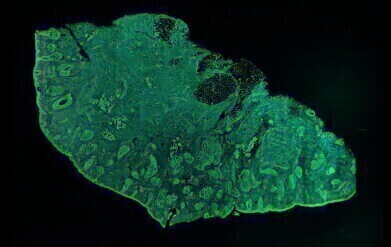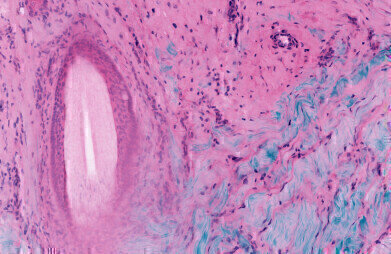-
 Magnification: Green is a fluorescent protein stain, red is a DNA stain, and blue is SHG in ordered Collagen tissue. DNA clusters in cell nuclei, proteins cluster in cell bodies, and collagen fibres form connective tissue in the skin sample. © Professor Michael Giacomelli/University of Rochester
Magnification: Green is a fluorescent protein stain, red is a DNA stain, and blue is SHG in ordered Collagen tissue. DNA clusters in cell nuclei, proteins cluster in cell bodies, and collagen fibres form connective tissue in the skin sample. © Professor Michael Giacomelli/University of Rochester -
 Magnification of a false-colour Masson’s Trichrome image of a cm-scale tissue sample measured with two-photon imaging. Pink is a fluorescent protein stain, Purple is a DNA stain, and blue is SHG in Collagen connective tissue. © Professor Michael Giacomelli/University of Rochester
Magnification of a false-colour Masson’s Trichrome image of a cm-scale tissue sample measured with two-photon imaging. Pink is a fluorescent protein stain, Purple is a DNA stain, and blue is SHG in Collagen connective tissue. © Professor Michael Giacomelli/University of Rochester
Fluorescence
Using Fluorescence Imaging for Improved Outcomes in Skin Cancer Surgery
Jan 16 2023
University of Rochester Professor Michael Giacomelli recently received NIH funding for his project, ‘Fluorescence microscopy for evaluation of Mohs surgical margins’. His research objective is to enable real-time evaluation of pathology in skin tissue with an order of magnitude reduction in processing time as compared to frozen sections.
The most common forms of cancer worldwide are basal cell carcinoma and squamous cell carcinoma. Mohs surgery is a widely used technique for the treatment of nonmelanoma skin cancer that obtains extremely low recurrence rates by imaging tissue as it is removed from the body to ensure complete resection. Mohs Micrographic Surgery, also called Mohs Surgery, is a specialised technique to remove non-melanoma skin cancers.
Nonmelanoma skin cancer (NMSC) is primarily diagnosed by histologic analysis of skin biopsy specimens in kerosene sections, which takes days to weeks before a formal diagnosis is made. Two-photon fluorescence microscopy (TPFM) has the potential for point-of-care diagnosis of NMSC and other dermatologic conditions, which could allow diagnosis and treatment at the same site.
Professor Giacomelli developed a way to image multiple depth slices without frozen section processing‚ by implementing two-photon imaging, widely used in the neurosciences to noninvasively image slices at different depths in living brains. The lab team's research has adapted these fluorescence imaging technologies with rapid tissue labelling and image processing technologies. This enables real-time assessment of pathology in skin tissue. processing time compared to frozen sections has been reduced by an order of magnitude. The data collection time is further reduced using the lower-noised silicon photomultiplier detectors developed by Giacomelli’s group.
2-photon fluorescence microscopy can provide rapid point-of-care diagnosis of non-melanoma skin cancer through real-time imaging of fresh tissue biopsies.
Toptica Photonics’ femtosecond laser system - FemtoFiber ultra 920 - chosen for the next iteration of the Giacomelli lab’s microscope is a possible solution for applications in non-linear microscopy like two-photon excitation of fluorescent proteins and SHG based contrast mechanisms. With an emission wavelength of 920 nm, it provides the highest peak power for imaging with green and yellow fluorescent protein markers (GFP, YFP) commonly used in pathology, neurosciences and other laser-related biophotonic disciplines. Researchers appreciate the usability of the system since it is both, maintenance free and very compact.
More information online
Digital Edition
Lab Asia 32.2 April
April 2025
Chromatography Articles - Effects of small deviations in flow rate on GPC/SEC results Mass Spectrometry & Spectroscopy Articles - Waiting for the present to catch up to the future: A bette...
View all digital editions
Events
Apr 27 2025 Portland, OR, USA
Making Pharmaceuticals Exhibition & Conference
Apr 29 2025 Coventry, UK
Apr 30 2025 Peshawar, Pakistan
May 11 2025 Vienna, Austria
May 13 2025 Oklahoma City, OK, USA


-(3).jpg)

















